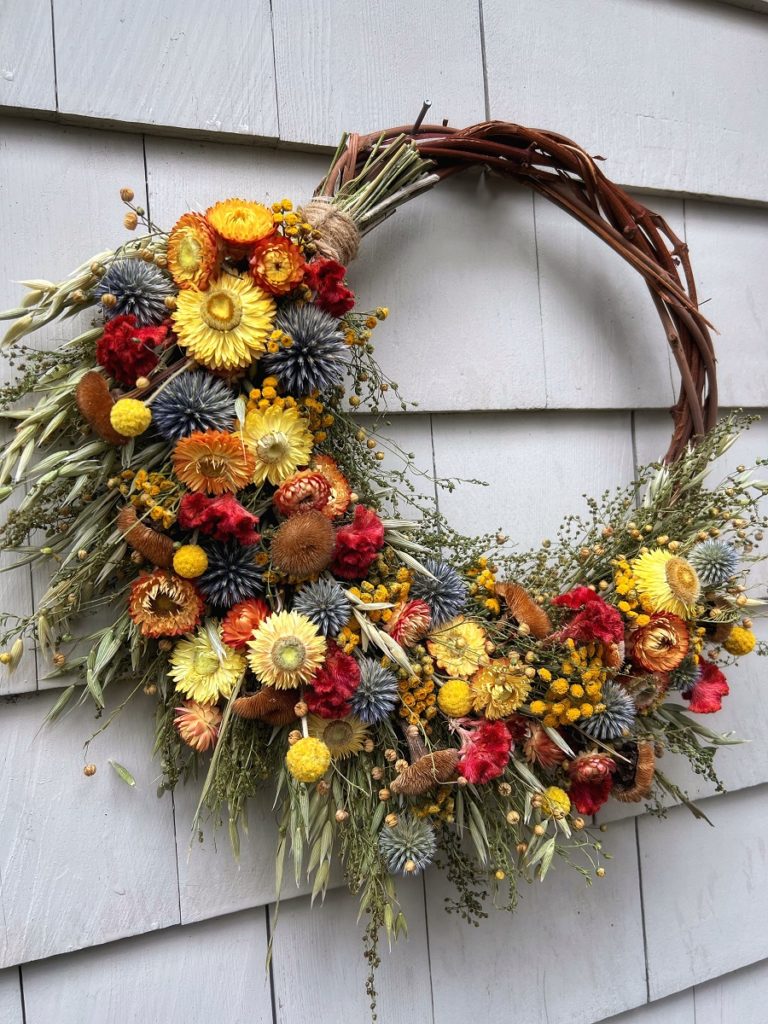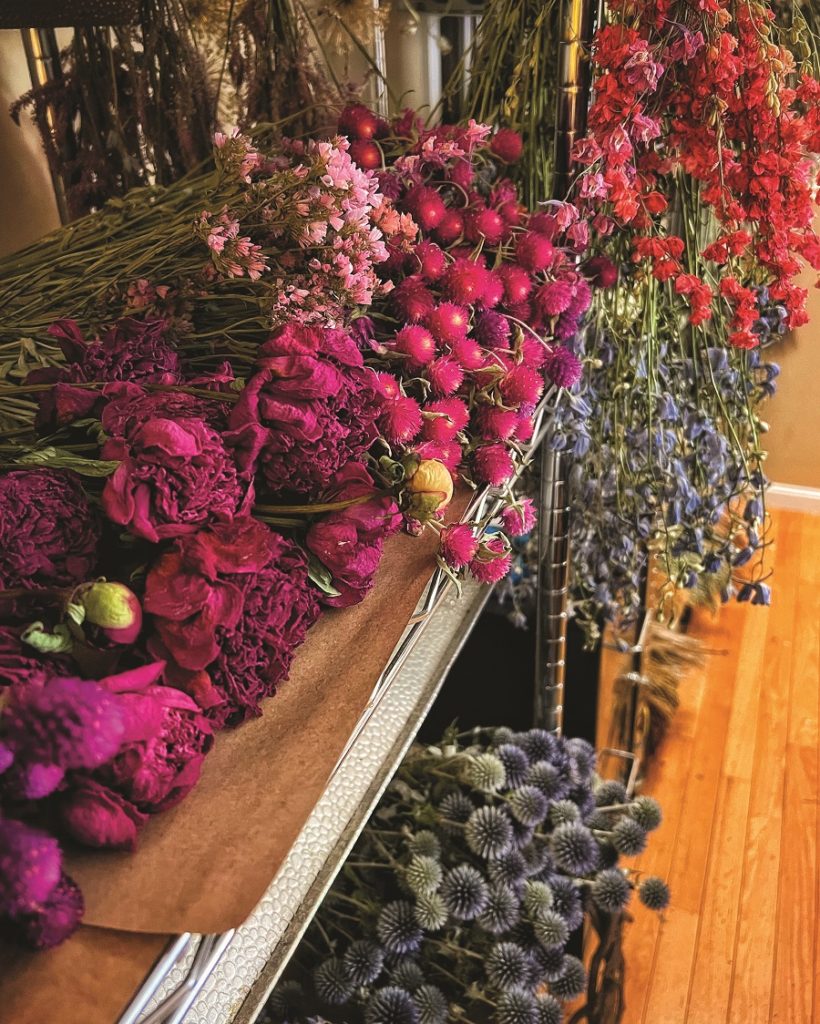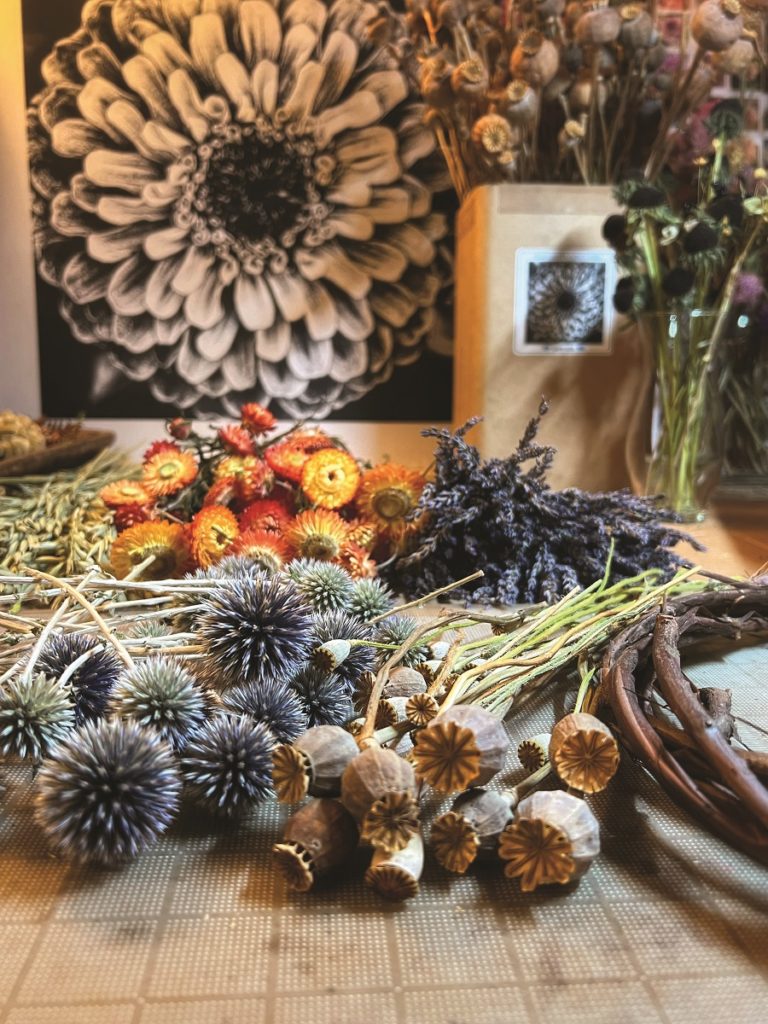It took a while for Meryl Gartside, the owner of Blue Lobster Flower Farm, to find a way to extend her flower-focused business into the winter months. “I don’t have a greenhouse,” says Gartside. She used to think, “Once the season’s over, it’s over.”

Then she began experimenting with drying her flowers. “This has given me a whole new season,” she says. “I’ll go through the holidays up until Valentine’s Day making wreaths with dried flowers, and then I’ll start my seeds for next year.”
Gartside does all of her drying on her property in Brewster in a small shed, which she will clear out in early spring to make space for grow lights and seedlings. “It’s very fulfilling to take something all the way from a seed to the finished product,” she says. At present, the whole shed is filled with dried flowers. “It’s like having your palette right in front of you.”

Her wreaths, which will be on sale this weekend at Rugosa Gallery’s holiday market in Eastham, are informed by her background in design.
Gartside attended the Mass. College of Art and Design and then worked as a graphic designer in Boston before moving to England, where her “love for all things flowers just took off,” she says. After returning to the U.S., she sold perennials and ran a garden design business in New Jersey before moving to the Cape and starting Blue Lobster seven years ago. She grows her flowers on three small parcels of land owned by friends and family in Brewster and Truro.

“All the elements that go into any design also go into flower design,” Gartside says. “You want to get textures and colors and make it dynamic.” Her wreaths are mostly asymmetrical. She likes to reveal some of the base, typically created from foraged Virginia creeper and grape vines. In one of her first wreaths, purple globe thistles dot a thick circle of vines. The quarter of the wreath that is left bare provides a counterpoint to the softer texture of the flowers.
In other wreaths, Gartside works with a wider variety of materials. “I look at my shelf and just start combining,” she says. “I like to make it feel like it just fell together.” Of course, that’s not the case. In one wreath, a composition in shades of white, she mixes the soft textures of spindly grasses with compact, bristly buds. Other wreaths are made up of pure saturated colors. Straw flowers, she says, hold their color very well. “But when things fade, the muted tones are beautiful, too.”

One of her favorite things about dried arrangements is the freedom to mix and match from different seasons. “When you do an arrangement with fresh flowers, you’re limited to what’s growing at that time,” says Gartside. “Working with dry flowers, I can combine a dahlia from September with a hellebore from March.
“People have the misconception that you dry flowers because they are left over,” Gartside continues. But working with dried flowers is more intentional than that. It involves learning the differences between flowers and how they behave when they’re drying. Flowers dry best in an environment that is dry and dark and has low humidity. She air-dries all her flowers, hanging them upside down in her shed, which is outfitted with a dehumidifier that keeps the air at 40 percent humidity.

She suggests cutting straw flowers before they are fully open. “Once they are cut and hung upside down, they will continue to open,” she says. “If you wait until they are all open, they will blow out and shatter when drying.” Peonies, on the other hand, can be cut at their prime: “You’ll get the same exact thing in dried form.” One of her favorite items to play with are the dried pods of poppies.
Last year she was not satisfied with the results she had with goldenrod, so this year she picked it when the buds were tighter, yielding a better product. “I’d say experiment,” she tells those interested in drying their own flowers. “That’s the best way to get a good result.

“Dried flowers were really popular in the ’70s and ’80s, but they fell out of fashion,” Gartside adds, noting how people began to see them as “dusty, musty-looking arrangements.” But recently she’s noticed a comeback. She’s received enthusiastic responses to her work, which surprised her. She sells from her Brewster shed — often selling out — and posts her pieces on Instagram, where she now has more than 15,000 followers. Her wreaths, which sell for upwards of $100, can last a year before their colors begin to fade. She recommends periodically cleaning them with a hair dryer on a low, cool setting.
The wreaths are especially striking at this time of year because “in the winter people just crave color. They want to see it,” Gartside says. “This is a nice way of capturing the summer.”
Wreaths and Other Visual Treats
The event: A holiday market
The time: Saturday, Dec. 17, noon to 8 p.m., and Sunday, Dec. 18, 10 a.m. to 3 p.m.
The place: Rugosa Gallery, 4100 State Hwy., Eastham
The cost: Free



